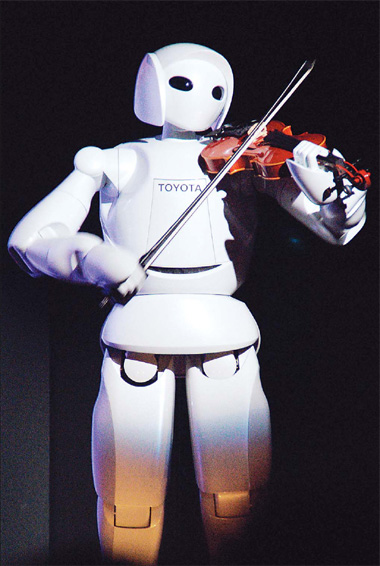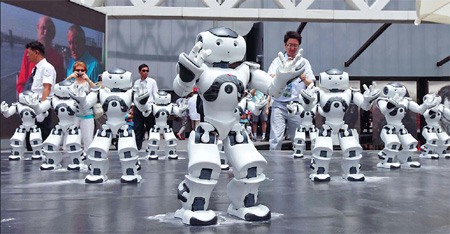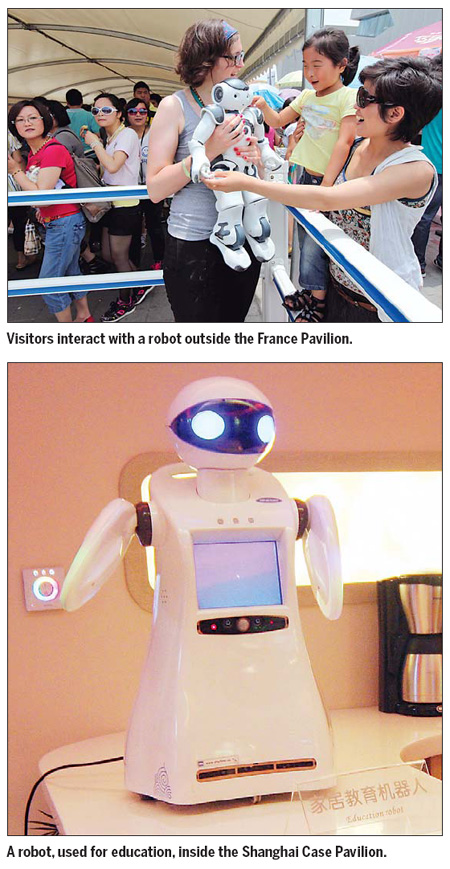Robots at your beck and call
 |
| A robot plays a violin inside the Japan Pavilion. |
 |
| Robots perform at the France Pavilion. |
Chinese maids and beleaguered spouses may be a thing of the past in the next decade or so when "robo-ayis" take over household chores, and care for the elderly and those with debilitating diseases, French robotics experts said at the Expo.
Contrary to Hollywood's presentation of advanced robots as cyborgs that can travel through space and time, morph into vehicles or terminate the mothers of yet-to-be-born babies, the more prosaic reality is they will probably start off helping us do the dishes or dial 911 in case of an emergency, said Bruno Maisonnier, CEO of Aldebaran Robotics.
"The 'robotic revolution' will begin in the next few years when we will see robots starting to emerge in niche areas. Within 10 years there will be robots everywhere in the domestic sphere," he told Exposure after introducing Nao, a programmable humanoid robot, as the France Pavilion's technological mascot.
"It's much better than science fiction. In science fiction robots are machines. In real life they are going to be personal assistants. They are going to help."
Think of them as friendly little Auto-bots armed with brooms and face-recognition skills instead of fearsome arsenals of weaponry.
"Of course if you want something just to clean your floor, it won't be humanoid. Maybe it will look more like a small box. But for human interaction and educational purposes, you need a humanoid. In 12 to 15 years, I believe elderly people will have such a robot as they realize it can add another 10 years to their life."
Maisonnier expects robots' integration into society to accelerate as governments begin to define them within the penumbra of social welfare benefits.
Nao, a WiFi-compatible robot with built-in sensory algorithms that can detect faces, joins a growing cast of non-human performers inside the Expo Garden.
This includes the Macao Pavilion's Clint Eastwood-impersonating ambassador called "Jack", Japan's violin-playing robots made by Toyota, clunky metallic versions of the 2010 Expo mascot Haibao, and Miguelin, a 6.5-meter-tall head-swiveling baby inside the Spain Pavilion.
Some of their manifestations are gimmicky - Spain claims the electronically animated Miguelin can breathe - but demand is growing for the technology that powers them.
"We've already had a lot of requests on behalf of autistic children, who cannot relate to people, but they can relate to objects. In this case, robots become the missing link," said Maisonnier.
"Nao has four built-in microphones, movement sensors and cameras, so if you are blind, he can detect where you are. He can download the news online and read it to you. He can notify spouses of people with Alzheimer's disease when there is a problem and call an ambulance."
He might also be able to beat you at a game of soccer. Nao is the soccer-playing robot used in the Standard Platform League of Robocup, the world's largest annual robotics competition, which was held recently in Singapore.
Recently, at the France Pavilion, 20 of the omni-directional robots performed a synchronized dance to the strains of Maurice Ravel's Bolero. They will perform in smaller numbers inside the pavilion and the Paris City Pavilion at the Urban Best Practices Area every day until the Expo ends on Oct 31.
The 10-minute show on their first day at the Expo drew applause but also saw several of the robots malfunction and fall over, gaffes that staff blamed on the heat, wind and general problems with stability on an uneven stage. The routine took five employees three months to complete - hardly the speed of breakneck development.
As such, no one really knows how long the integration of robots into daily life is going to take. Even the robots at the Japan Pavilion have not come that far from their forebears at the Aichi World Expo five years ago; the key difference being that the current versions play violins, whereas their predecessors played simpler musical instruments.
Despite this haltering development curve, Toyota President Akio Toyoda announced several months ago that he expects his company to be selling more robots than cars by 2030.
Nao, which comes in several versions ranging from $2,500 to $15,000 per unit, is not yet ready to go commercial but it is outselling its competitors at educational institutions and research labs in the United States and Asia.
The University of Tokyo snapped up scores of them earlier this month, as have China's Tongji and Zhejiang universities. Several Shanghai-based learning institutes and MIT in the US are now in talks with the company.
"We have a new world coming and this is why big companies such as Toyota are investing millions of dollars in this technology," said Maisonnier.
"What you are seeing now is more fantastic than fiction. There are maybe 10,000 to 15,000 science fiction writers in the world today, but we have 10 times that many people writing applications for us."
He said that "robots will never have emotions", but according to engineer Jerome Monceaux, it is possible to fake them.
"We're now building feeling indicators inside them using output simulators so if the robot walks into a room and there's no one there, or there are no toys to play with, his expression will change and he will look sad or maybe sleepy," he said.
According to Maisonnier, robots will eventually have the capacity to morph metal and flesh, but humanoids that look more like iRobot's Sonny than Arnold Schwarzenegger's waxy Terminator will dominate the market.
This belief is fueled by popular support for a hypothesis, mapped out by Japanese master robot-maker Masahiro Mori in 1970, known as the "uncanny valley". This refers to a graph positing that robots attract greater human empathy the more human-like they appear until they hit a point where they look too similar to us and start to generate revulsion.
Such sentiments were backed up by feedback from older Chinese tourists inside the Spain Pavilion last month as they stood in the shadow of a 6-meter-high robot that looks like a three-month old infant with early signs of decrepitude. "I thought babies were supposed to be cute but this one is scary because its skin looks older than mine," said Wang Xiabing, a middle-aged man from neighboring Zhejiang province.
Christina Ieong, director of the Macao Pavilion, said that if somebody tried to sell her a robot that looked human, she would simply hire a human instead.
Ieong flew to the US to meet "Jack", an RT3 RoboThespian of human proportions that bears more than a passing resemblance to Sonny in the Hollywood movie iRobot. Made by British firm Engineered Arts, he can whistle, make jokes and speak several languages, but his feet are bolted to the ground. He comes in three versions ranging from $54,144 to $117,930.
"I fell in love with him in 10 minutes and decided he was the one," said Ieong. "There are plenty of robots that look more human, or like pretty girls, especially in Japan, but there's a lack of humanity about them that is off-putting. We wanted a robot that looks like a robot."
Jack fills a niche several grades up from the millions of robots that perform perfunctory roles at factories worldwide, but he's no Johnny 5. On the plus side, technicians can fix him remotely from the UK via computer if he short-circuits.
"The rest of us are already working 13 hours a day so he really fills a gap that we need," said Ieong. "He never gets sick and he's always cheerful. We'll take him back home with us after the Expo."
However it is Japan, not Britain or France, that people associate with the cutting edge of robotics. Osaka University's Professor Hiroshi Ishiguro is a case in point: He was experimenting with "geminoids", synthetic human replicas that can be controlled by their user remotely, years before Bruce Willis started investigating the murder of robotic doppelgangers in the movie Surrogates in 2009.
Maisonnier said, to some extent, each country develops humanoid robots in its own image.
"We had lots of reporters ask us, 'What's the difference between French robots and those made in other countries?' So we told them: 'You're the journalists. You go and find out and let us know'," said Maisonnier.
"When they came back they said: 'The American robots are too militaristic. The Japanese robots are too technical. We prefer the French ones. They're friendlier and more fun.'"
Just the way you want your ayi to be.

 0
0 






